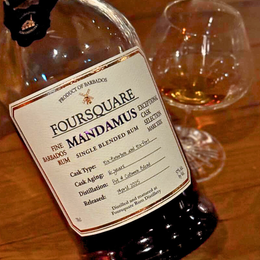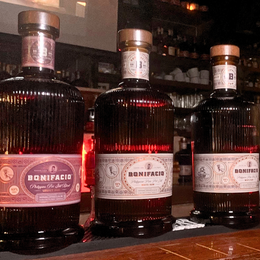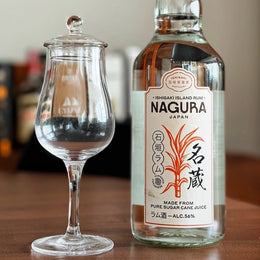Editor's note: This is Part 1 of Jigs' 3-part series on Luisita Rum. Jigs interviews Paco Cojuangco, Luisita Rum's "Farmer Behind the Brand" about the brand's fascinating history, production process, philosophy on rum and the future plans of Luisita, and he also reviews three bottles of Luisita's rums. This first part focuses on the brand's history and one of Luisita's rums. Read Part 2 here and Part 3 here.

The Philippines isn't that much of a rum-drinking nation.
If an American and Scot would be told that Jack Daniel's and Johnny Walker were among the world's bestselling whisky brands in recent years, one can expect that neither will be surprised. After all, bourbon and Scotch are the national drinks of the United States and Scotland, respectively. The same, however, won't likely be true if a Filipino were told that Tanduay was among the world's bestselling rum brands in recent years.
In the Philippines, beer, gin, and brandy reign supreme among Filipinos, and I don't need to look at the data to say this with confidence. Go into a local bar, restaurant, home, or any other random place where a group of Filipinos are drinking, and I'm willing to bet that in most cases, a bottle of rum isn't on the table. I can also confidently say that the same idea can be extended to what is often considered as "premium alcohol." Most Filipinos wouldn't associate the word "premium" with Philippine rum and, instead, would associate the term with imported drinks like whisky and wine.

This popular culture at home has unsurprisingly translated abroad; the Philippines does not seem to be considered a major player in the arena of premium rum. Don Papa has pioneered the flag of premium Philippine rum, especially with its success in the Europe, but most rum enthusiasts still seem to turn to rum from established rum-producing places like Jamaica, Barbados, Cuba, or Martinique. To strengthen the local and international presence of premium Philippine rum, I believe that more quality local brands are needed. Luisita Rum is hoping to fulfill that need.
Established in 2016 and run by the Tarlac Distillery Corporation (TADISCO) under the company Central Azucarera de Tarlac, Luisita Rum is a brand of single-estate rum produced in the province of Tarlac.
I've had the absolute pleasure of speaking with Paco Cojuangco, Luisita Rum's "Farmer Behind the Brand," and in this and two succeeding articles, I'll be sharing what he had to say about Luisita Rum. The first part of our lengthy conversation, presented below, focuses on the brand's history, the next part involves their production process, and the third details Paco's philosophy on rum and the future plans of Luisita. Of course, each piece will also contain a review of a single expression of Luisita Rum. My additions, mostly for clarity, are presented in brackets.

[Jigs]: Tell us about the history surrounding TADISCO, particularly when it first distilled rum and how it eventually began producing rum under the Luisita brand.
[Paco]: TADISCO is quite old; it was incorporated in 1958. Around that time, the paternal side of my family had bought into the Luisita estate, and along with the estate came the plantation that involved the sugar mill and the distillery put up by Tabacalera [also known as the “Compañía General de Tabacos de Filipina”]. TADISCO was incorporated to handle the distilling side of the operations – all alcohol sales – and Central Azucarera de Tarlac, which was already incorporated, was left alone for the sugar manufacturing.
The still that was eventually acquired by TADISCO was constructed in 1920 and put up in 1928, which was the first year of production for both the sugar mill and the distillery. We have newspaper clippings that show that Tabacalera was supplying the Americans with “spirit” during World War 2. There’s a story that the Japanese wanted to bomb the plantation but opted not to after someone shouted “sake!” after seeing the column still. In essence, the alcohol kept this place through the war.
After the war, Tabacalera was divesting their interests from the previous Spanish colonies like the Philippines, and the plantation landed with my family. TADISCO started manning the column still then, and this was definitely one of the big distilleries up until the ‘70s. Up until the ‘80s and ‘90s, we sold distillate to brands like La Tondeña Rum (owned by Ginebra San Miguel), Añejo Rum, Emperador, and maybe even to Tanduay Rum at one point when it was still owned by the Elizalde group. All of these contracts stopped because those brands put up their own distilleries but also because they wanted us to remove this particular banana note in our distillate.

[Jigs]: How did your family or the estate’s workers’ perception of rum change throughout the years?
[Paco]: Before the cusp of the war, my family was already in Tarlac, and they had a mill there called the Paniqui Sugar Mill [“paniqui” is a Spanish term taken from the Filipino word “paniki,” which means “bat”]. In that mill, there was also a still – I believe it was a pot still because they were making heavier rum – and they were making rum, called Paniqui Rum. From what I remember, they were using a pot still and column still, and the column still would just pump out distillate in huge volumes, while the pot still will be their “flavoring” because of its heavier aromas. They’d blend both and sometimes either color or age the rum. After distilling for a while, the war happened, but they were able to continue and expand production after the war simply because the rum was a byproduct of sugarcane.
Now, after the war, there was a shortage in gas in the country as only the military had access to it. When the American soldiers stationed at the local base found out that my great grandfather used ethanol for his jeep’s fuel, they thought that the alcohol was being put to waste and ended up trading gas for my family’s alcohol. That rum production must have stopped in the ‘50s when my family acquired Luisita, the acquisition of which was always the dream of my great grandfather. Around the ‘80s, my great uncle purchased virgin oak barrels from countries like France and Australia, put distillate from Paniqui and Luisita in those barrels, and stored them in a cellar. This rum, however, was only consumed by the family during special occasions.
In all, we can see how my family had their own small production of rum – or some semblance of it – before supplying distillate to other local rum producers after acquiring Luisita and eventually releasing our own brand.

[Jigs]: What things were done to enable or prepare TADISCO to produce and sell rum at the rate it does today?
[Paco]: In 2016, this project of Luisita Rum came along after the mill was acquired from the bigger paternal clan in 2014 by my father and his business partner, who were both wine aficionados and had dreams of running a vineyard. My father’s business partner’s nephew, who works in the international alcohol trade, chanced upon some barrels from Heaven Hill and Wild Turkey, and he suggested we make rum. One meeting led to another, and eventually, they had the idea of running a business with the concept of being a vineyard in the tropics. We already had the fields and the still, so the barrels were the missing piece.
We also got in touch with a consultant who retired after working for the West Indies Rum Distillery. After trying our distillate and picking up on the banana note that the big producers dropped us for, he gave his comments with the distillery men and women. From there, we purchased a reverse osmosis unit to filter out minerals from our deep well. We filled our first barrels that year.
Giving credit where it’s due, we saw Don Papa had entered the market at that time, and the way they premiumized their brand played a big role into how we eventually positioned Luisita as a premium, honest-to-goodness rum as opposed to being a mass-market rum. It was important that we made that decision to stick to heritage, authenticity, and what the community stood for.
To increase production capacity, we first decreased capacity. We have three other columns, but they are fully stainless steel and cannot produce the kind of distillate we are looking for. Column #3, which is what we use for the rum, is all copper. The rest produce almost neutral spirit. Our consultant challenged us to lower the final proof of the distillate, and this cuts production into half. We did this to focus purely on creating a specific distillate that we found smelled and tasted good. Eventually, we started looking into fermentation: SOPs, temperatures, making the process stable, etc. Lots of attention to detail and returning to basics.

[Jigs]: What were the challenges you encountered as you started building the brand in the Philippines?
[Paco]: By looking at other existing brands, we knew where we wanted to position ourselves. Coming from wine, we were already familiar with the concept of terroir and the craftsmanship involved in doing things in a small way. We decided that we didn’t want to nor can operate on the level of volume. Don Papa operated in a new category of premium Philippine rum, so we wanted to be there, too – on the premium shelf. We knew that our distillate was of quality, so we followed Don Papa as they carried the torch to bring Philippine spirits in a particular direction.
Here’s a good anecdote for how difficult it was to begin the brand in the Philippines. There’s a certain government agency that is in charge of giving producers operational authority, and they sent an inspector to check the facility. I remember that she pointed out a problem: food in a manufacturing plant cannot touch wood. Wait ‘till she finds out that the rum is inside the wood, I thought. After we told her how we aged the rum, she was so shocked and lectured us about the food safety implications of the rum. She also told us about other production and labeling requirements that would make it difficult for us to acquire operational authority. We were new to the game in this area, so they weren’t familiar with barrel aging and the general process of making rum.
I politely asked if I could show her how whisky and wine producers do it, and at the end of the day, she understood. It was challenging to explain the production process, but she took it really well, and eventually, we got the green light.

Luisita Single Barrel (OR-1004) Philippine Rum, 64.6% - Review
This single-barrel, single-estate, molasses-based rum was distilled using a copper column still in 2015, bottled in 2021, and naturally presented (without use of chill-filtration or additives) at 64.6% strength. It's also the first rum released by Luisita that has been exclusively aged in an ex-Oloroso sherry cask (no. OR-1004) from Jerez de la Frontera, Spain. I purchased it for $68.
Nose: Rich and syrupy. The sherry influence is clear, pleasantly restraining the molasses aroma from being too sweet and cloying. The base notes consist of prunes, grape stalks, and cappuccino, all while being coated by toasted rubber and spice, a mix of cinnamon and cumin. Accents of rock salt. Over time, there are raisins, shoe wax, caramelized bananas, and a soft touch of roasted sesame seeds.
Palate: The mouthfeel is thick and velvety. Brown sugar simple syrup, day-old Sun-maid raisins, and coffee jelly drizzled with chocolate sauce. Glazed-meat and warm fond, leading to a trail of sweet soy sauce. Consistent with the nose, it's great that the sweetness is not overpowering and, instead, plays well with cinnamon spice and oak. A brief jab of seared steak that shifts onto cured Spanish sausages and ends with toasted raisin bread. Underneath those heavier flavors lie subtle yet distinct rosemary, almonds, honey, and pears.
Finish: The finish is long and with a layer of muted tannins, grapes, and herbs.
My Thoughts
My favorite aspects of this rum are its texture and the consistent richness in its development. I don't often gravitate toward sherried rums for two reasons: I feel that the sherry influence might keep me from encountering the breadth of flavors that different styles of rum can offer, and I worry that the use of sherry might be a signal of mediocre distillate, which is unfortunately commonly the case in the whisky world, where I, as a rum enthusiast, initially came over from. I'm pleased to realize that this rum does not fall into either trap. The sherry influence is evident and, to an extent, keeps the rum from being balanced, but the unique character of the distillate still shines through, and both complement each other well. I've tried Luisita's first bottling in its blended series, and the house style that takes the helm in that rum is clearly present in this sherried single cask bottling, though it takes a while before that house style emerges. Finally, its richness is not stagnant, and those who read my reviews will know that I place value on how aromas and flavors move and develop; this single cask bottling checks that box, too. Obviously, at $68, this is an utter steal.
Unless otherwise stated, all images are courtesy of Jigs Alonzo/@thebrowndram.

The Brown Dram
A Filipino living in Metro Manila, Jigs is a whisky and rum enthusiast. His passion for spirits has led him to develop interests in photography and, now, writing. Reach him and check out his work on Instagram @thebrowndram!







